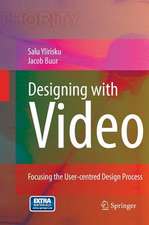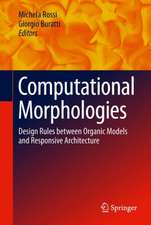Solid Modelling and CAD Systems: How to Survive a CAD System
Autor Ian Stroud, Hildegarde Nagyen Limba Engleză Hardback – 6 mai 2011
The main feature of Solid Modelling and CAD Systems is a logical analysis of the techniques and basic solid modelling methods used in modern CAD systems. The book goes on to describe, among other subjects:
- two-dimensional shape definition methods,
- the command interface and graphics,
- databases and data exchange,
- early-phase design, and
- command files and command structures.
| Toate formatele și edițiile | Preț | Express |
|---|---|---|
| Paperback (1) | 2107.67 lei 6-8 săpt. | |
| SPRINGER LONDON – 23 aug 2016 | 2107.67 lei 6-8 săpt. | |
| Hardback (1) | 2106.06 lei 6-8 săpt. | |
| SPRINGER LONDON – 6 mai 2011 | 2106.06 lei 6-8 săpt. |
Preț: 2106.06 lei
Preț vechi: 2568.36 lei
-18% Nou
Puncte Express: 3159
Preț estimativ în valută:
403.05€ • 419.23$ • 332.74£
403.05€ • 419.23$ • 332.74£
Carte tipărită la comandă
Livrare economică 15-29 aprilie
Preluare comenzi: 021 569.72.76
Specificații
ISBN-13: 9780857292582
ISBN-10: 0857292587
Pagini: 689
Ilustrații: XXII, 689 p.
Dimensiuni: 155 x 235 x 51 mm
Greutate: 1.09 kg
Ediția:2011
Editura: SPRINGER LONDON
Colecția Springer
Locul publicării:London, United Kingdom
ISBN-10: 0857292587
Pagini: 689
Ilustrații: XXII, 689 p.
Dimensiuni: 155 x 235 x 51 mm
Greutate: 1.09 kg
Ediția:2011
Editura: SPRINGER LONDON
Colecția Springer
Locul publicării:London, United Kingdom
Public țintă
Professional/practitionerCuprins
1. Case Studies.- 2. How Objects Are Modelled.- 3. 2D Shape Definition.- 4. Operations and Functionality.- 5. Geometry.- 6. Non-manifold Models.- 7. The CAD Interface and Graphical Output.- 8. Information and Properties.- 9. Databases and Data Exchange.- 10. Features.- 11. Early-Phase Design.- 12. History, Parametric Parts and Programming.- 13. Assemblies.- 14. CAD in a Community.- 15. Projects.
Notă biografică
Ian Stroud has worked with solid modelling since 1977 and has a number of unique insights into how CAD systems work, which are shared in this book. Ian Stroud started work in the first research group in boundary representation solid modelling, headed by Ian Braid. He was responsible for developing the first versions of many operations used in CAD systems today. In 1980 he moved to Sweden to continue work on generalising models, an idea of Professor Torsten Kjellberg. Ian Stroud was responsible for making the ideas work and developed many of the data structure elements, the basic techniques and system philosophy behind these. Techniques used in modern systems, such as thickening sheet models, shelling and wire-frame extrusion, originate from him. He has continued to look at different aspects of modelling which will help system users to be more efficient in their work when they eventually arrive in commercial systems. Ian Stroud is also knowledgeable about many other modelling aspects, such as features, which underpin efficient communication between application areas. He also teaches a course on Computer-Aided Engineering for Master's level students for which many of the exercises in this book were developed.
Textul de pe ultima copertă
Solid Modelling and CAD Systems gives users an insight into the methods and problems associated with CAD systems. It acts as a bridge between users who learn interfaces without understanding how they work and developers who create systems without understanding the needs of the users.
The main feature of Solid Modelling and CAD Systems is a logical analysis of the techniques and basic solid modelling methods used in modern CAD systems. The book goes on to describe, among other subjects:
The main feature of Solid Modelling and CAD Systems is a logical analysis of the techniques and basic solid modelling methods used in modern CAD systems. The book goes on to describe, among other subjects:
- two-dimensional shape definition methods,
- the command interface and graphics,
- databases and data exchange,
- early-phase design, and
- command files and command structures.
Caracteristici
Enables practitioners to use CAD systems more efficiently Gives instructors a more thorough way of teaching students about CAD systems Includes a number of case studies Includes supplementary material: sn.pub/extras



























